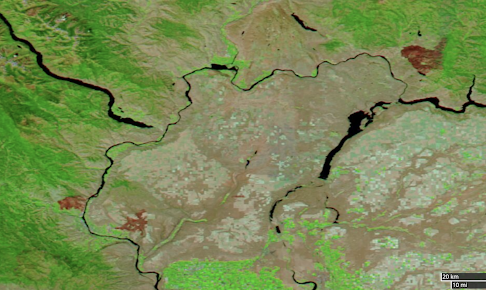Just as meteorologists were able to provide excellent forecasts regarding the heatwave, we are also able to contribute valuable one-week predictions of meteorological conditions that can lead to wildfires and smoke.
And the forecasts for the next week are favorable.
But before I provide those forecasts, let me show off some powerful weather satellite technology that really helps our society keep track of wildfire occurrence.
For example, our GOES (Geostationary Operational Environmental Satellite) covering the West Coast can spot the heat emissions from fires. Below is the image from last night, with the orange colors indicating fires. Several little fires in BC and northeast Washington, but the big action is over south-central Oregon. The biggest smoke plume too.
Other satellites (polar orbiting weather satellites) can view the earth in several wavelengths and can map out where fires have burned over the past several years. Here is such an image for mid-day yesterday (Saturday). The reddish areas are recent fires, while the green shows vegetation, including irrigated areas in the Columbia Basin.
A close-up view shows the recent Apple Fire near Wenatchee and the Chuweah Creek fire in the northwest portion of the image. Not much smoke from them now.
The Regional Wildfire Forecast
Today, several of the recent grass/range fires are under control and there is cool, moist onshore flow across western WA and Oregon. Most of the region is pretty much smoke free (see visible image)
Air quality is good (green circles in the AIRNOW graphic) for most of the region, with poor air quality limited to areas downstream of eastern WA and OR fires.
With a dry spring and the recent heatwave, the lower elevation fuels (e.g., grasses, bushes) are quite dry, and according to USDA Forest Service, they are ahead of schedule in drying by 2-3 weeks. The Forest Service also notes a positive about the dry conditions: less low-elevation fuels, since spring moisture promotes grass growth.
Another favorable is that the Northwest should not be warmer than normal: no heatwave for us is in sight, as a moderate trough of low pressure is parked right offshore.
And there are some other positives for the next week.
Many wildfires are started by lightning, particularly in remote, difficult-to-reach areas.
And the latest model forecasts suggest no lightning over Oregon, Washington, and southern British Columba.
And there is the question of wind. Strong winds play a critical role in starting fires (e.g., trees falling onto powerlines) and contributing to rapid fire growth. Fortunately, the latest model forecasts suggest a generally low-wind period.
The strongest winds east of the Cascade crest will during the late afternoon/early evening on the eastern slopes of that barrier, but even they will not be exceptional (see winds for the next week at Yakima below).
All this adds up to a period in which the meteorology will not be favorable for large, fast-spreading fires. It should also give wildland firefighters a chance to make progress against current blazes.
But don't get me wrong....fuels are dry at lower to middle elevations and we must be careful to avoid starting new blazes.
And we should also remember that wildfire is an essential part of the regional ecosystem and one that can not be excluded without eventually paying a heavy price, both in terms of enabling catastrophic large fires and in undermining the future health of our rangeland and forests.









I am not as optimistic as Cliff about fire weather conditions, especially in Eastern Washington, for the coming week. Lightning may not be a factor except possibly near the eastern border, but it will continue very dry with low humidity on most days and except for a brief cool down about mid week when the offshore trough moves in BC, temperatures will run above normal over much of the east side. This trough will also bring stronger winds mid week. Our grass fuels may not be as heavy this year but the Red Apple and Batterman fires near Wenatchee burned pretty hot and fast. Also, the timber fires in the Okanogan are not likely to be controlled for some time and could see significant spread.
ReplyDeleteHey Cliff - a little far away to make any definitive predictions, but I read that the latest ENSO readings are starting to strongly indicate a La Nina Fall and Winter pattern for 2021/22. Any thoughts yet? I would tend to think if the trend holds true, then that would be a good experience for the PNW.
ReplyDeleteNice to hear a level headed assessment W/ sat images to back it up not the sensationalism the media floods the airwaves with. thank you
ReplyDeletehttps://www.nytimes.com/2021/07/19/climate/bootleg-wildfire-weather.html?campaign_id=190&emc=edit_ufn_20210720&instance_id=35761&nl=updates-from-the-newsroom®i_id=51967655&segment_id=63918&te=1&user_id=6305d480d07054af2cbc3a0ccf3269e1
ReplyDelete